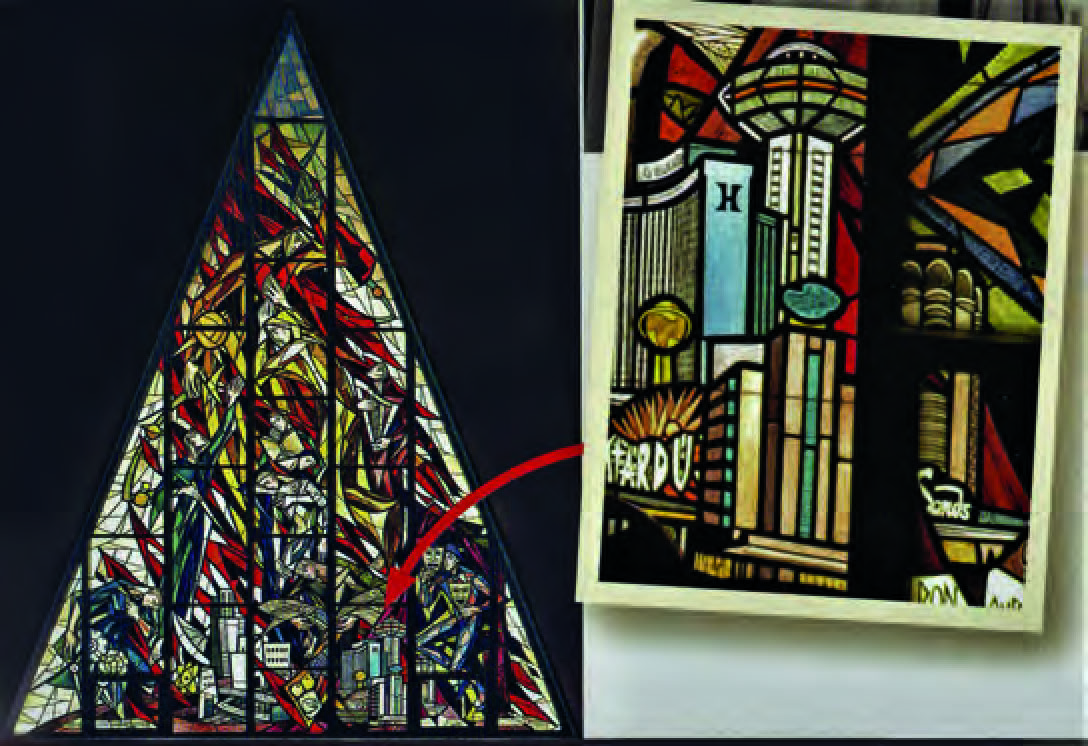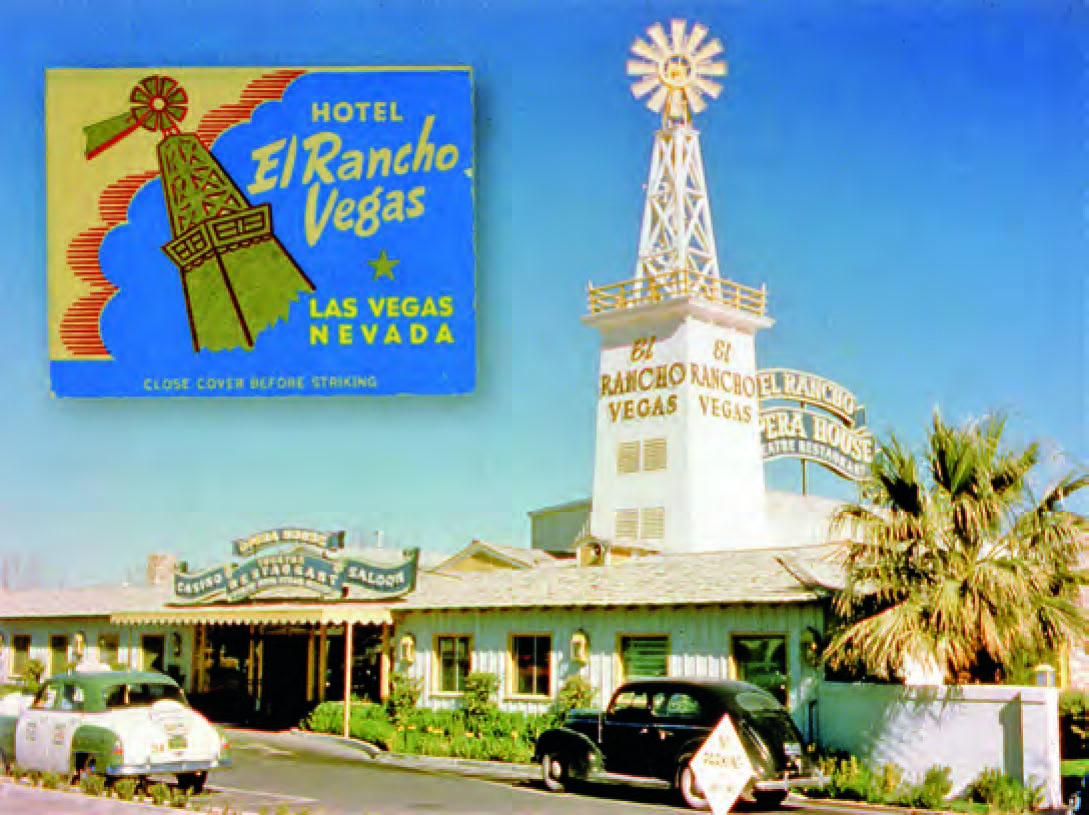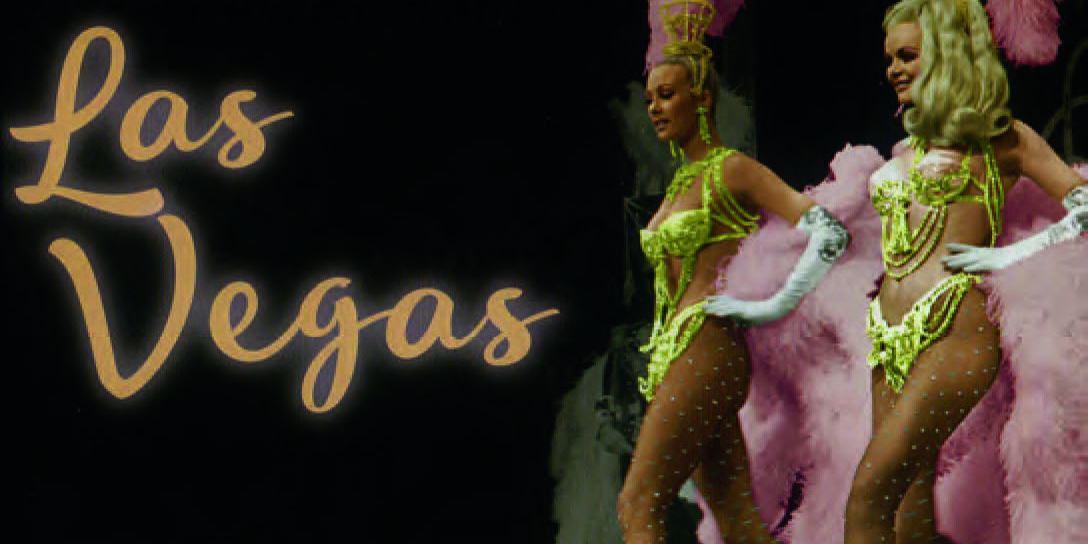Greetings from Las Vegas
By Peter Moruzzi
Layton, Utah: Gibbs Smith, 2019
Hardcover, 176 pages. $30
Reviewed by Douglas C. Towne
 I’ve finally found a roadside book that inspires me to skip the casinos and go to church instead on my next trip to Las Vegas.
I’ve finally found a roadside book that inspires me to skip the casinos and go to church instead on my next trip to Las Vegas.
Not for a confessional about any activities in Sin City, mind you. My misdeeds have been minor: lingering a tad too long at the complimentary Bloody Mary fountain at the El Morocco or using fireworks to ward off evil spirits at the Stardust, two long-demolished gambling halls.
My spiritual destination is the Guardian Angel Cathedral, just off the Strip, to witness the stunning example of Googie architecture designed by African American architect Paul R. Williams. The kicker is that some of the stained-glass windows depict long-demolished casinos, perhaps the only site where commercial archeology has been featured in this manner. The church was built in 1963 on property donated by Moe Dalitz, a mobster looking to improve his public image. This nugget, hidden in plain sight, was tossed my way while I was vicariously enjoying the city via Peter Moruzzi’s recent book, Greetings from Las Vegas.
I sheepishly admit that the book had sat on my night.stand for months. Not that I didn’t love vintage Vegas, but I thought there wasn’t much fresh to learn. Mea culpa to Mr. Moruzzi.
Greetings from Las Vegas is a tough book to put down. The dazzling montage of vintage photos, postcards, architectural sketches, and ephemera is like cruising Fremont Street in its heyday, albeit from the comfort of your Lazy Boy. Moruzzi unearthed rare glimpses of early Vegas; only a handful of the book’s 300 images were familiar to me.
But sometimes roadside picture books can be too sweet and leave me wanting something of substance to aid their digestion. This is where Moruzzi, a historian who graduated from the University of California, Berkeley, shines.
The book offers enough compelling text and captions to describe how a small railroad town in the desert at the turn of the 20th century morphed into the world’s entertainment capital by the 1970s. Restrained text drives the book, rather than just offering odd, dislocated facts interspersed among the pretty images.
The show really starts when Nevada legalized gambling in 1931. Moruzzi astutely notes that this often consisted of Fremont Street bars merely moving their backroom gambling tables up front. Then the neon and glitz were added to attract more customers. The author explains how The Meadows (the translation from Spanish of “Las Vegas”) was the first resort erected outside the city limits in 1931. The business was destroyed in a fire in 1936. Its proprietor, Tony Cornero, later became the owner of the gambling boat, S.S. Rex, anchored in Santa Monica Bay just outside the legislative reach of California authorities in the late 1930s, a topic worthy of another book.

A stained glass window at the Guardian Angel Cathedral features properties on the Vegas Strip.
Greetings from Las Vegas also dispenses with the myth that mobster Benjamin “Bugsy” Siegel creating the Las Vegas Strip when he opened the Flamingo Hotel in 1946. The Strip’s first hotel was El Rancho Vegas in 1941, though plans for this resort were proposed as far back as 1938. The original concept by architect Wayne McAllister was a more elaborate version of his Agua Caliente resort in Tijuana. Moruzzi spotlights The Strip’s early vitality by emphasizing that the Flamingo Hotel looked dated enough to require an extensive remodel only six years after its opening.
Besides the casino resorts, elegant restaurants, and neon motels, the book touches upon the Basic Magnesium Plant in nearby Henderson. This major industrial operation employed more than 13,000 people after it opened during World War II, and is often overshadowed by the earlier construction of Hoover Dam in helping shape the Las Vegas-Henderson metropolitan area.
Another bonus from the historical images is seeing how “normal” the city once appeared. There’s a Shell gas station kitty-corner to the Golden Nugget Gambling Hall on Glitter Gulch in one photo, a real estate pairing that wouldn’t happen today.

The El Rancho Vegas with its neon windmill was the first resort to open on the Strip.
The book’s flaws are minor. I spotted a couple of glitches, such as the photo labeled “1962” that features Catholic dignitaries posing with local casino operators/ mobsters “Ice Pick Willie” Alderman, Benny Binion, and Gus Greenbaum for the groundbreaking of the Guardian Angel Cathedral. In 1958 Greenbaum and his wife were murdered in their second home in Phoenix, a brazen crime in which the killers stayed to eat the steaks the couple had been preparing.
The other disappointment is that the book peters out rather than ending with a crescendo in the last chapter, “Swinging ’60s and Beyond.” But the complex changes Las Vegas was undergoing in becoming a metropolitan area make this period challenging to pin down in a few paragraphs. And who can get too excited about the resorts’ high-rise additions that looked like office buildings as “Corporate Vegas” took over? This chapter’s most riveting features are photos of sleek mid-century architectural masterpieces imploding, which is just plain sad.
Moruzzi has honed his craft well with similar books, including Havana Before Castro: When Cuba Was a Tropical Playground; Palm Springs Holiday: A Vintage Tour from Palm Springs to the Salton Sea; and Greetings from Los Angeles. I highly recommend Greetings from Las Vegas; reading it might even be a religious experience.
Douglas Towne is the editor of the SCA Journal and might be the only person ever profiled by both Nevada and Las Vegas Healthy & Fit magazines.
This book review originally appeared in the SCA Journal, Fall 2020, Vol. 38, No. 2.The SCA Journal is a semi-annual publication and a member benefit of the Society for Commercial Archeology.
More Book Reviews


